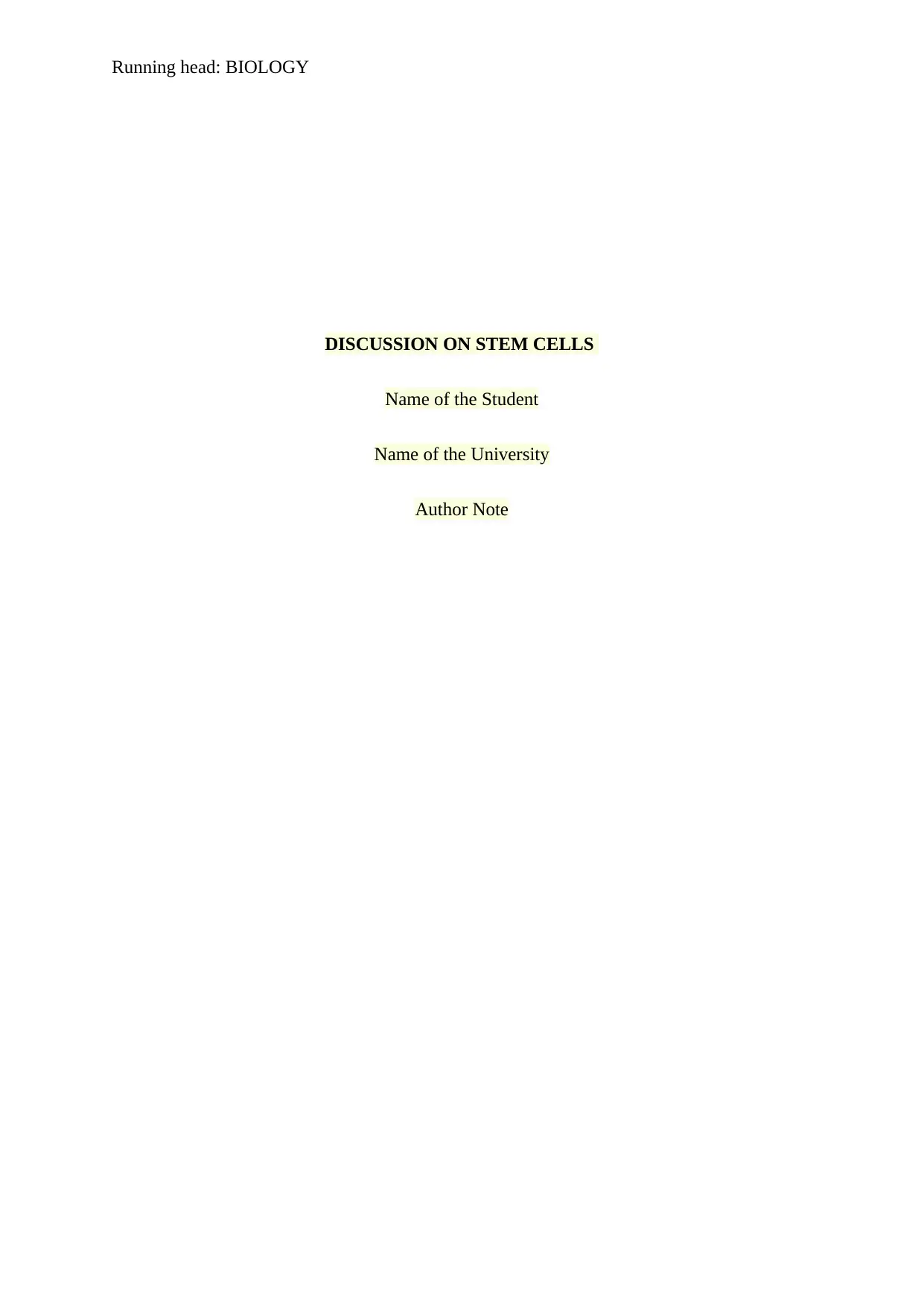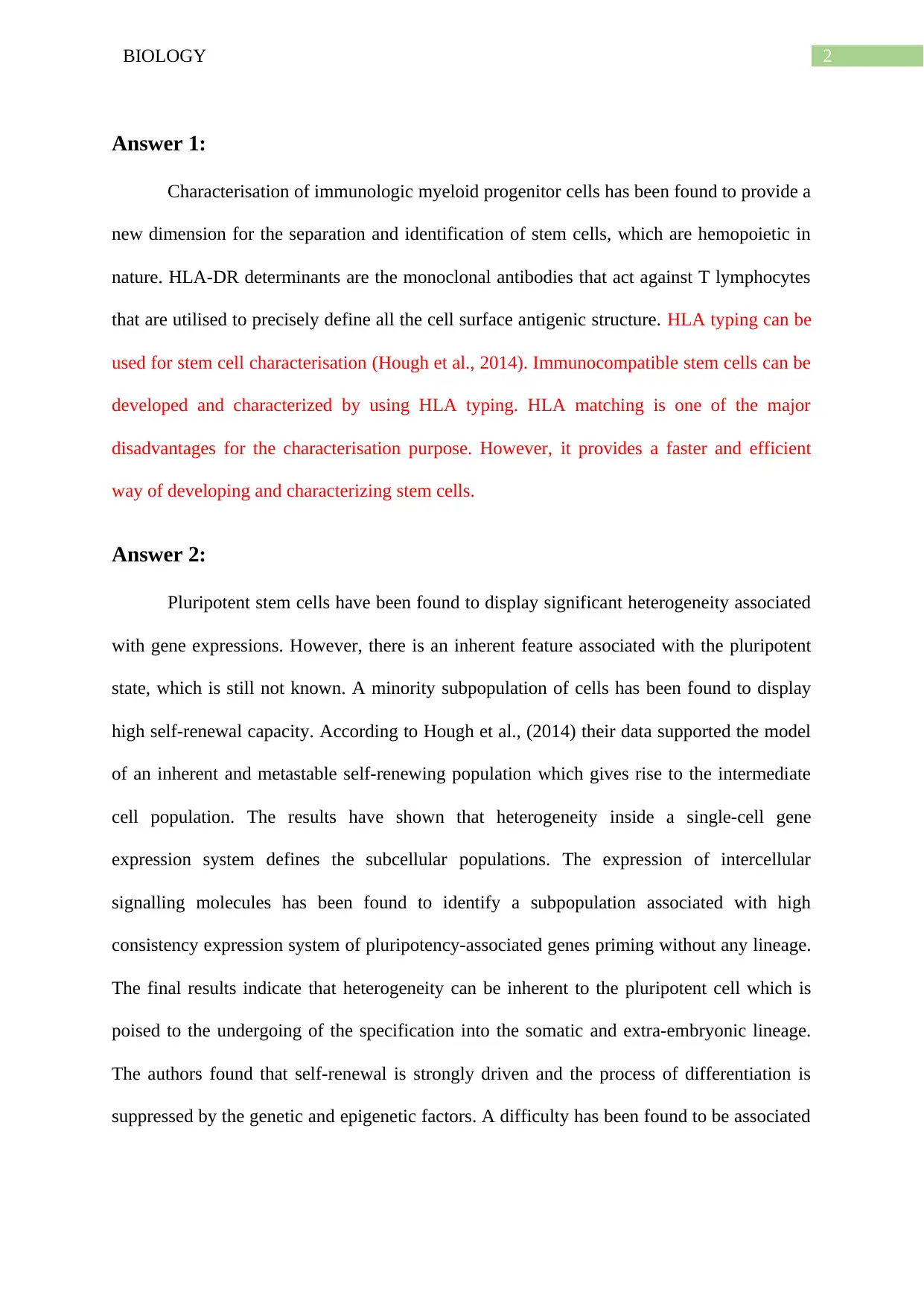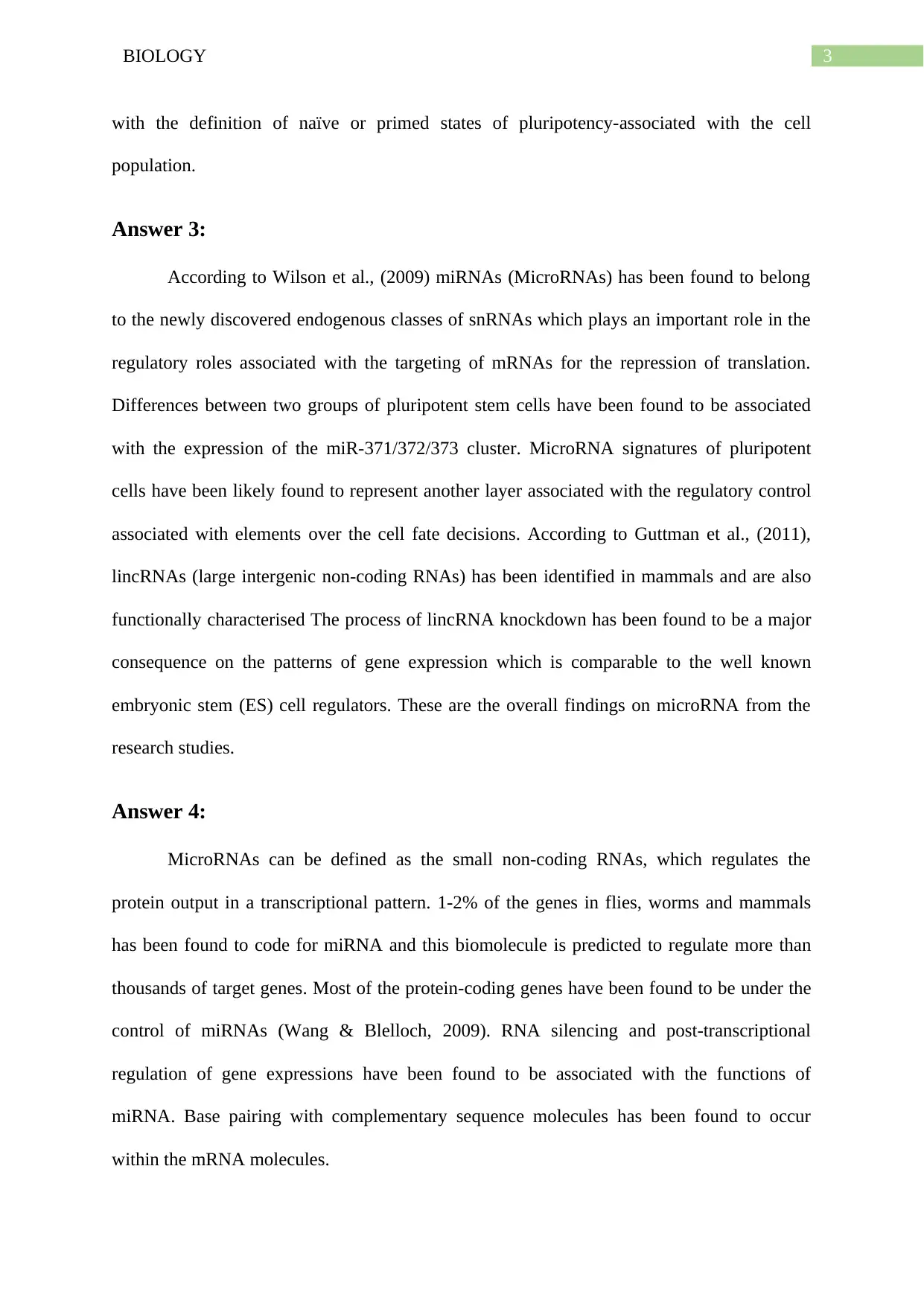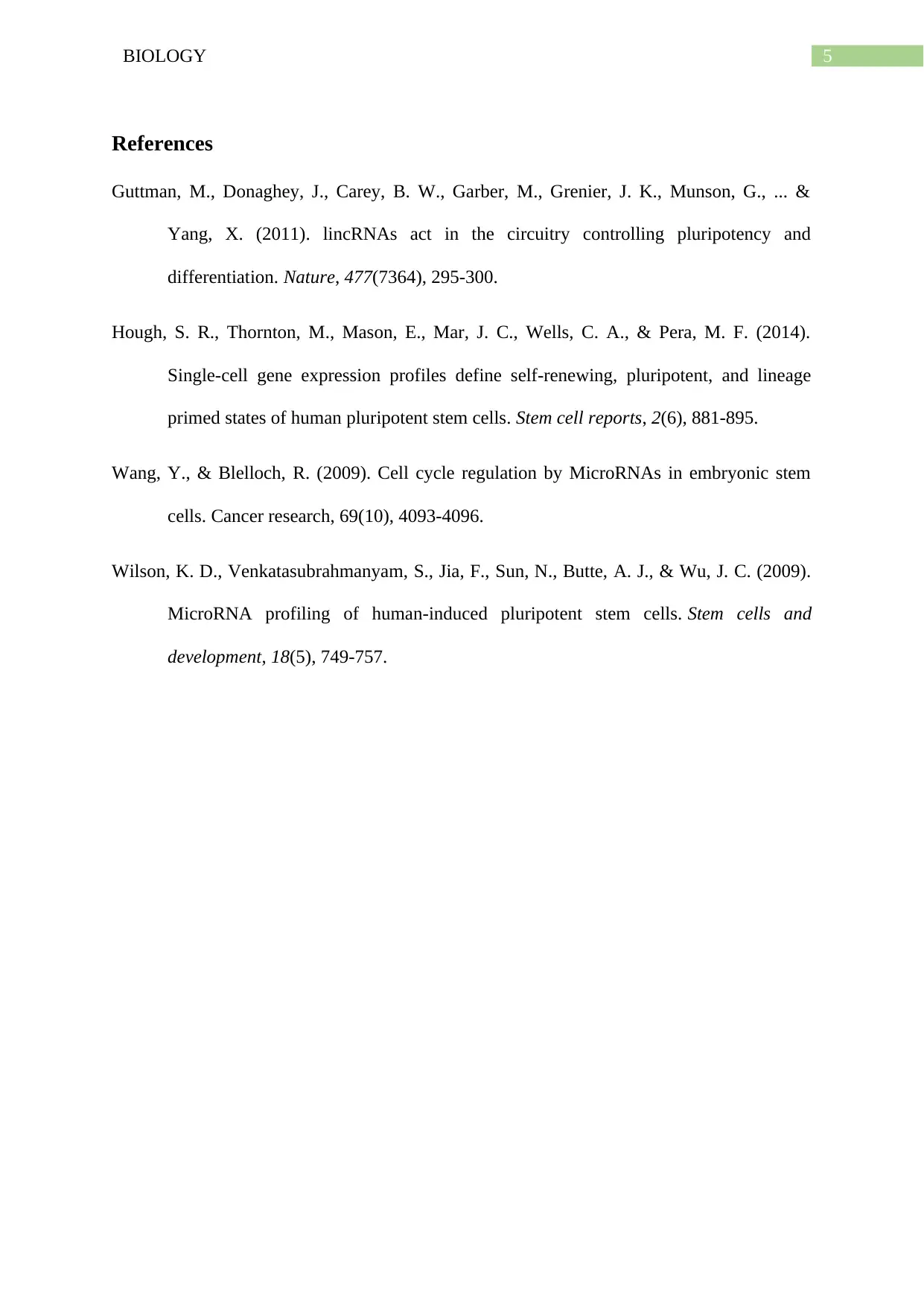University Biology: Discussion on Stem Cell Characterization
VerifiedAdded on 2022/08/13
|6
|844
|10
Discussion Board Post
AI Summary
This biology discussion assignment examines stem cell research, focusing on the characterization of stem cells, particularly through HLA typing. It explores the heterogeneity in pluripotent stem cells and the role of gene expression in defining cell states, referencing studies on single-cell gene expression profiles. The assignment delves into the functions of microRNAs (miRNAs) and large intergenic non-coding RNAs (lincRNAs) in regulating gene expression and influencing cell fate decisions within stem cells. It highlights the significance of these regulatory elements in the processes of self-renewal and differentiation, emphasizing their impact on the molecular circuitry of embryonic stem cells. The assignment references key research articles to support the discussion.

Running head: BIOLOGY
DISCUSSION ON STEM CELLS
Name of the Student
Name of the University
Author Note
DISCUSSION ON STEM CELLS
Name of the Student
Name of the University
Author Note
Paraphrase This Document
Need a fresh take? Get an instant paraphrase of this document with our AI Paraphraser

1BIOLOGY
Table of Contents
Answer 1:...................................................................................................................................2
Answer 2:...................................................................................................................................2
Answer 3:...................................................................................................................................2
Answer 4:...................................................................................................................................3
References..................................................................................................................................4
Table of Contents
Answer 1:...................................................................................................................................2
Answer 2:...................................................................................................................................2
Answer 3:...................................................................................................................................2
Answer 4:...................................................................................................................................3
References..................................................................................................................................4

2BIOLOGY
Answer 1:
Characterisation of immunologic myeloid progenitor cells has been found to provide a
new dimension for the separation and identification of stem cells, which are hemopoietic in
nature. HLA-DR determinants are the monoclonal antibodies that act against T lymphocytes
that are utilised to precisely define all the cell surface antigenic structure. HLA typing can be
used for stem cell characterisation (Hough et al., 2014). Immunocompatible stem cells can be
developed and characterized by using HLA typing. HLA matching is one of the major
disadvantages for the characterisation purpose. However, it provides a faster and efficient
way of developing and characterizing stem cells.
Answer 2:
Pluripotent stem cells have been found to display significant heterogeneity associated
with gene expressions. However, there is an inherent feature associated with the pluripotent
state, which is still not known. A minority subpopulation of cells has been found to display
high self-renewal capacity. According to Hough et al., (2014) their data supported the model
of an inherent and metastable self-renewing population which gives rise to the intermediate
cell population. The results have shown that heterogeneity inside a single-cell gene
expression system defines the subcellular populations. The expression of intercellular
signalling molecules has been found to identify a subpopulation associated with high
consistency expression system of pluripotency-associated genes priming without any lineage.
The final results indicate that heterogeneity can be inherent to the pluripotent cell which is
poised to the undergoing of the specification into the somatic and extra-embryonic lineage.
The authors found that self-renewal is strongly driven and the process of differentiation is
suppressed by the genetic and epigenetic factors. A difficulty has been found to be associated
Answer 1:
Characterisation of immunologic myeloid progenitor cells has been found to provide a
new dimension for the separation and identification of stem cells, which are hemopoietic in
nature. HLA-DR determinants are the monoclonal antibodies that act against T lymphocytes
that are utilised to precisely define all the cell surface antigenic structure. HLA typing can be
used for stem cell characterisation (Hough et al., 2014). Immunocompatible stem cells can be
developed and characterized by using HLA typing. HLA matching is one of the major
disadvantages for the characterisation purpose. However, it provides a faster and efficient
way of developing and characterizing stem cells.
Answer 2:
Pluripotent stem cells have been found to display significant heterogeneity associated
with gene expressions. However, there is an inherent feature associated with the pluripotent
state, which is still not known. A minority subpopulation of cells has been found to display
high self-renewal capacity. According to Hough et al., (2014) their data supported the model
of an inherent and metastable self-renewing population which gives rise to the intermediate
cell population. The results have shown that heterogeneity inside a single-cell gene
expression system defines the subcellular populations. The expression of intercellular
signalling molecules has been found to identify a subpopulation associated with high
consistency expression system of pluripotency-associated genes priming without any lineage.
The final results indicate that heterogeneity can be inherent to the pluripotent cell which is
poised to the undergoing of the specification into the somatic and extra-embryonic lineage.
The authors found that self-renewal is strongly driven and the process of differentiation is
suppressed by the genetic and epigenetic factors. A difficulty has been found to be associated
⊘ This is a preview!⊘
Do you want full access?
Subscribe today to unlock all pages.

Trusted by 1+ million students worldwide

3BIOLOGY
with the definition of naïve or primed states of pluripotency-associated with the cell
population.
Answer 3:
According to Wilson et al., (2009) miRNAs (MicroRNAs) has been found to belong
to the newly discovered endogenous classes of snRNAs which plays an important role in the
regulatory roles associated with the targeting of mRNAs for the repression of translation.
Differences between two groups of pluripotent stem cells have been found to be associated
with the expression of the miR-371/372/373 cluster. MicroRNA signatures of pluripotent
cells have been likely found to represent another layer associated with the regulatory control
associated with elements over the cell fate decisions. According to Guttman et al., (2011),
lincRNAs (large intergenic non-coding RNAs) has been identified in mammals and are also
functionally characterised The process of lincRNA knockdown has been found to be a major
consequence on the patterns of gene expression which is comparable to the well known
embryonic stem (ES) cell regulators. These are the overall findings on microRNA from the
research studies.
Answer 4:
MicroRNAs can be defined as the small non-coding RNAs, which regulates the
protein output in a transcriptional pattern. 1-2% of the genes in flies, worms and mammals
has been found to code for miRNA and this biomolecule is predicted to regulate more than
thousands of target genes. Most of the protein-coding genes have been found to be under the
control of miRNAs (Wang & Blelloch, 2009). RNA silencing and post-transcriptional
regulation of gene expressions have been found to be associated with the functions of
miRNA. Base pairing with complementary sequence molecules has been found to occur
within the mRNA molecules.
with the definition of naïve or primed states of pluripotency-associated with the cell
population.
Answer 3:
According to Wilson et al., (2009) miRNAs (MicroRNAs) has been found to belong
to the newly discovered endogenous classes of snRNAs which plays an important role in the
regulatory roles associated with the targeting of mRNAs for the repression of translation.
Differences between two groups of pluripotent stem cells have been found to be associated
with the expression of the miR-371/372/373 cluster. MicroRNA signatures of pluripotent
cells have been likely found to represent another layer associated with the regulatory control
associated with elements over the cell fate decisions. According to Guttman et al., (2011),
lincRNAs (large intergenic non-coding RNAs) has been identified in mammals and are also
functionally characterised The process of lincRNA knockdown has been found to be a major
consequence on the patterns of gene expression which is comparable to the well known
embryonic stem (ES) cell regulators. These are the overall findings on microRNA from the
research studies.
Answer 4:
MicroRNAs can be defined as the small non-coding RNAs, which regulates the
protein output in a transcriptional pattern. 1-2% of the genes in flies, worms and mammals
has been found to code for miRNA and this biomolecule is predicted to regulate more than
thousands of target genes. Most of the protein-coding genes have been found to be under the
control of miRNAs (Wang & Blelloch, 2009). RNA silencing and post-transcriptional
regulation of gene expressions have been found to be associated with the functions of
miRNA. Base pairing with complementary sequence molecules has been found to occur
within the mRNA molecules.
Paraphrase This Document
Need a fresh take? Get an instant paraphrase of this document with our AI Paraphraser

4BIOLOGY

5BIOLOGY
References
Guttman, M., Donaghey, J., Carey, B. W., Garber, M., Grenier, J. K., Munson, G., ... &
Yang, X. (2011). lincRNAs act in the circuitry controlling pluripotency and
differentiation. Nature, 477(7364), 295-300.
Hough, S. R., Thornton, M., Mason, E., Mar, J. C., Wells, C. A., & Pera, M. F. (2014).
Single-cell gene expression profiles define self-renewing, pluripotent, and lineage
primed states of human pluripotent stem cells. Stem cell reports, 2(6), 881-895.
Wang, Y., & Blelloch, R. (2009). Cell cycle regulation by MicroRNAs in embryonic stem
cells. Cancer research, 69(10), 4093-4096.
Wilson, K. D., Venkatasubrahmanyam, S., Jia, F., Sun, N., Butte, A. J., & Wu, J. C. (2009).
MicroRNA profiling of human-induced pluripotent stem cells. Stem cells and
development, 18(5), 749-757.
References
Guttman, M., Donaghey, J., Carey, B. W., Garber, M., Grenier, J. K., Munson, G., ... &
Yang, X. (2011). lincRNAs act in the circuitry controlling pluripotency and
differentiation. Nature, 477(7364), 295-300.
Hough, S. R., Thornton, M., Mason, E., Mar, J. C., Wells, C. A., & Pera, M. F. (2014).
Single-cell gene expression profiles define self-renewing, pluripotent, and lineage
primed states of human pluripotent stem cells. Stem cell reports, 2(6), 881-895.
Wang, Y., & Blelloch, R. (2009). Cell cycle regulation by MicroRNAs in embryonic stem
cells. Cancer research, 69(10), 4093-4096.
Wilson, K. D., Venkatasubrahmanyam, S., Jia, F., Sun, N., Butte, A. J., & Wu, J. C. (2009).
MicroRNA profiling of human-induced pluripotent stem cells. Stem cells and
development, 18(5), 749-757.
⊘ This is a preview!⊘
Do you want full access?
Subscribe today to unlock all pages.

Trusted by 1+ million students worldwide
1 out of 6
Your All-in-One AI-Powered Toolkit for Academic Success.
+13062052269
info@desklib.com
Available 24*7 on WhatsApp / Email
![[object Object]](/_next/static/media/star-bottom.7253800d.svg)
Unlock your academic potential
Copyright © 2020–2025 A2Z Services. All Rights Reserved. Developed and managed by ZUCOL.


